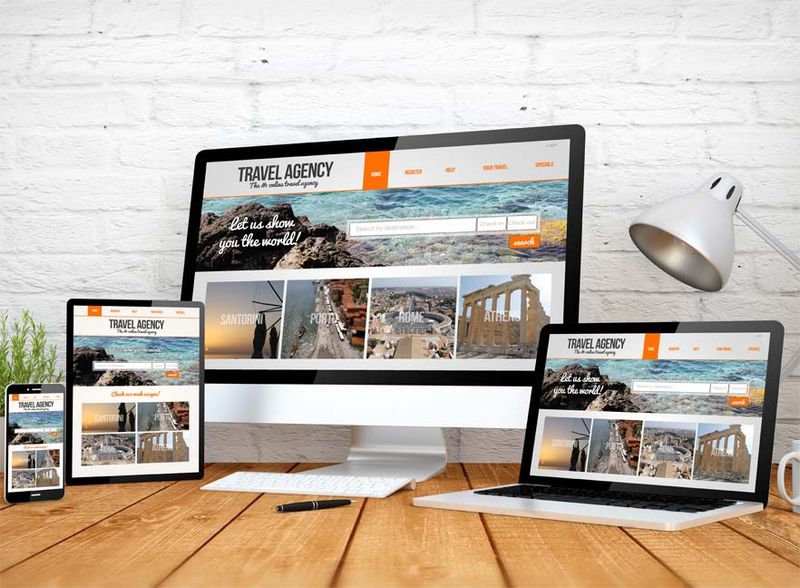Comprehending the Influence of Receptive Web Style on Mobile Website Traffic
As the number of mobile customers proceeds to rise, the requirement for sites to effortlessly adapt to numerous display dimensions comes to be progressively obvious. This adaptability not just enhances customer experience however likewise plays an important role in preserving site visitors and minimizing bounce prices - Web design near me.
Relevance of Mobile Compatibility
With the proliferation of smartphones and tablets, more users are accessing the web via mobile gadgets than ever previously. Mobile compatibility straight affects an internet site's accessibility, performance, and general efficiency, influencing customer involvement and complete satisfaction.
Incorporating responsive website design is an important technique to attaining mobile compatibility. This style method allows a website to automatically adjust its layout and content based on the screen size and alignment of the tool being made use of (Web design near me). This adaptability ensures that all customers have a smooth experience, despite whether they are using a mobile phone, desktop, or tablet
In addition, mobile compatibility is carefully connected to search engine optimization (SEO) Organizations should focus on mobile compatibility to stay competitive and ensure their electronic presence is easily accessible to the broadest feasible audience, ultimately driving development and engagement.
Enhancing User Experience
A smooth individual experience stands at the heart of effective internet design, acting as a vital factor in maintaining and involving visitors. In the context of receptive web layout, enhancing individual experience on mobile phones is necessary. As the number of mobile customers remains to increase, web sites must adjust to different display dimensions and orientations without endangering performance or appearances. This adaptability guarantees that individuals can conveniently communicate and navigate with content, regardless of the gadget they utilize.
Key components of a boosted mobile individual experience include fast loading times, instinctive navigation, and accessible web content. Instinctive navigation ensures that customers can discover info rapidly, while accessible web content enables for readability and communication without unneeded zooming or scrolling.
Moreover, giving a constant visual and functional experience throughout gadgets establishes trust fund and dependability, urging return check outs. By prioritizing these components, receptive website design not just deals with mobile target markets yet additionally promotes a positive perception of the brand name, ultimately boosting general customer experience.
Boosting Mobile Interaction
To effectively increase mobile interaction, internet developers need to focus on producing compelling and interactive experiences that captivate individuals' interest. Applying attributes such as touch-friendly navigation, concise content, and instinctive customer interfaces can dramatically enhance user interaction and fulfillment.

Furthermore, leveraging customization strategies, such as customized content referrals based on customer habits and preferences, can develop much more meaningful communications and encourage repeat visits. By concentrating on these aspects, internet designers can significantly improve mobile engagement, ensuring that customers remain engaged and invested in the content, ultimately driving This Site higher retention rates and individual complete satisfaction.
Search Engine Optimization Perks of Responsive Style
As internet developers improve mobile interaction with responsive techniques, another considerable advantage emerges in the realm of seo (SEO) Receptive web style (RWD) plays a crucial function in boosting a website's exposure and position find this on internet search engine. By ensuring a seamless user experience across devices, receptive design lowers bounce prices, a vital metric that internet search engine take into consideration when identifying website importance and quality.
Google, which regulates a considerable share of the search market, supporters for responsive style as the market standard. A solitary link framework, promoted by RWD, simplifies crawling and indexing processes for online search engine robots. This efficiency enhances a website's ease of access and makes it easier for internet search engine to understand and rank content appropriately.
Additionally, responsive style enhances loading times, an additional variable heavily weighted in Google's algorithms. A faster, much more efficient website improves user satisfaction, leading to longer web page sees and higher engagement degrees, which positively affect SEO positions. Furthermore, RWD sustains the application of optimized metadata and tags, making certain that web content is appropriately customized for mobile and desktop computer individuals alike.
Strategies for Efficient Implementation
When carrying out receptive internet design, comprehending crucial methods is essential for success. This method likewise helps enhance material, concentrating on crucial aspects that boost user experience.
Second, utilize versatile grid designs and scalable pictures. A versatile grid makes sure that the web site's design changes effortlessly throughout different screen sizes. Likewise, making use of scalable pictures that adapt based on resolution protects against distortion and keeps photo quality, improving the total aesthetic.
Third, optimize loading times. Usage strategies such as minifying and pressing pictures CSS and JavaScript files to make sure rapid web page loads. Rate is critical for preserving mobile customers who might desert slow-loading sites.

Finally, leverage analytics to check efficiency and individual habits. Analytics give insights right into how users communicate with the recommended you read website, leading further optimization initiatives to fulfill evolving requirements. By following these methods, companies can effectively apply responsive internet layout, optimizing their mobile traffic potential.
Final Thought
By adjusting designs for different display dimensions, it dramatically improves user experience, minimizes bounce prices, and raises check out duration. This flexibility addresses the growing number of mobile customers, fosters involvement with intuitive navigation, and makes certain quick filling times, which are essential for preserving site visitors and boosting total digital presence.
In the context of responsive internet design, improving customer experience on mobile tools is vital.Trick aspects of an enhanced mobile customer experience consist of fast packing times, instinctive navigating, and accessible material.To successfully improve mobile involvement, internet designers should focus on producing engaging and interactive experiences that astound users' attention. Executing functions such as touch-friendly navigation, succinct material, and instinctive customer interfaces can dramatically enhance user interaction and contentment.
Additionally, RWD sustains the execution of enhanced metadata and tags, ensuring that material is suitably customized for mobile and desktop computer customers alike.